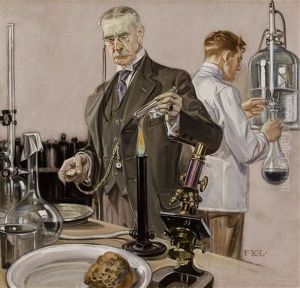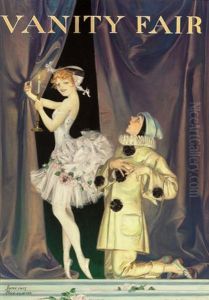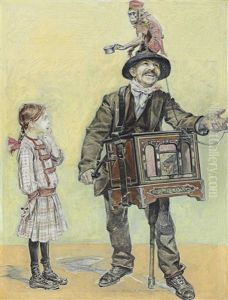Frank Xavier Leyendecker Paintings
Frank Xavier Leyendecker, often known as Frank X. Leyendecker, was an American illustrator born on January 19, 1877, in Montabaur, Germany. Along with his more famous brother, Joseph Christian Leyendecker (J.C. Leyendecker), Frank immigrated to the United States with their family in 1882. The Leyendeckers settled in Chicago, where Frank and his brother would eventually study at the Chicago Art Institute. Seeking further education in art, Frank later attended the Académie Julian in Paris, refining his skills and style under the tutelage of renowned instructors like Jean-Joseph Benjamin-Constant and Jean-Paul Laurens.
Frank X. Leyendecker's career in illustration blossomed in the early 20th century, where he became known for his distinct and vibrant cover illustrations for popular magazines of the time, including 'The Saturday Evening Post' and 'Collier’s.' His work, although overshadowed by his brother J.C. Leyendecker's fame, was distinguished by its elegant line work and a unique flair that combined elements of Art Nouveau with a nascent Art Deco movement. Frank specialized in fashion illustrations and advertisements, capturing the opulence and style of the era with a keen eye for detail and color.
Despite his talent and contributions to early 20th-century American illustration, Frank X. Leyendecker's life was marked by personal challenges, including his health and struggles with his sexuality in a less accepting era. His career, while successful, was often seen in the shadow of his brother's more prolific output and renown. Frank's professional and personal life were deeply interconnected with J.C.'s, with the brothers sharing a studio and living together for most of their lives. This close relationship, while supportive in terms of their artistic endeavors, also contributed to Frank's difficulties in establishing his own identity outside of his brother's influence.
Frank X. Leyendecker's life came to a tragic and early end when he died on April 18, 1924, at the age of 47. The cause of his death is often attributed to an overdose, which was possibly accidental, stemming from his chronic health issues. Despite his premature death, Frank's artwork remains a testament to his skill and a snapshot of the stylistic transitions that marked the early 20th century in American illustration. His contributions, though less recognized than his brother’s, continue to be appreciated by art historians and collectors for their beauty and historical value.
























